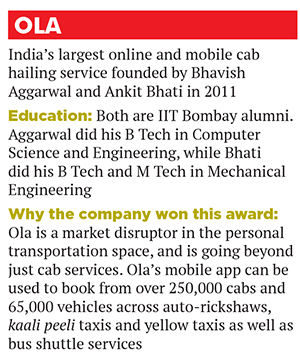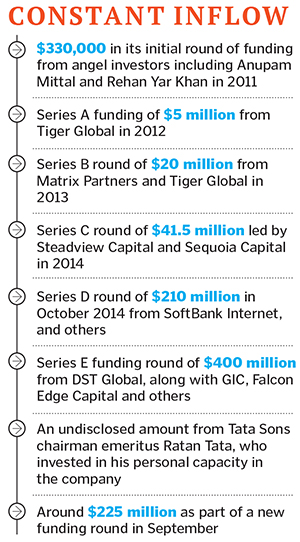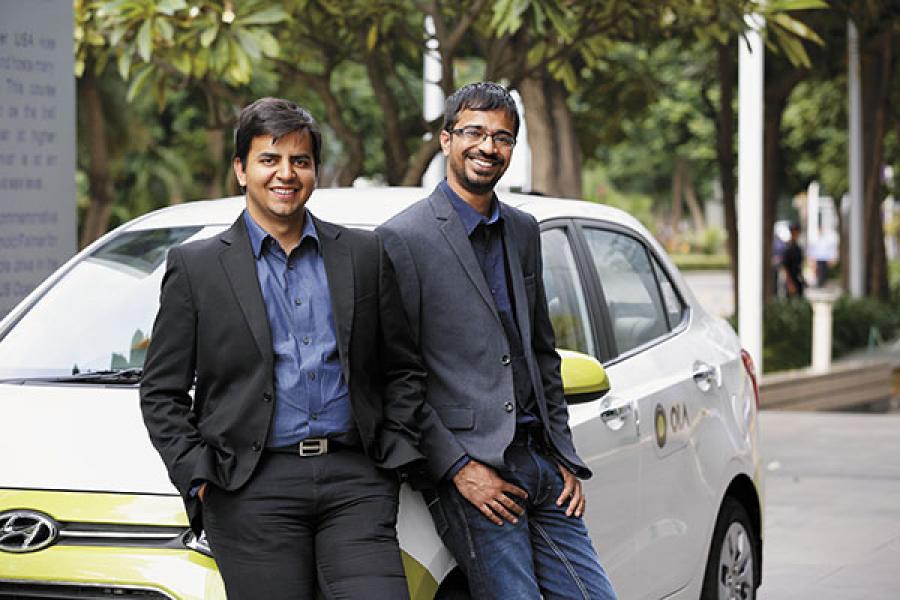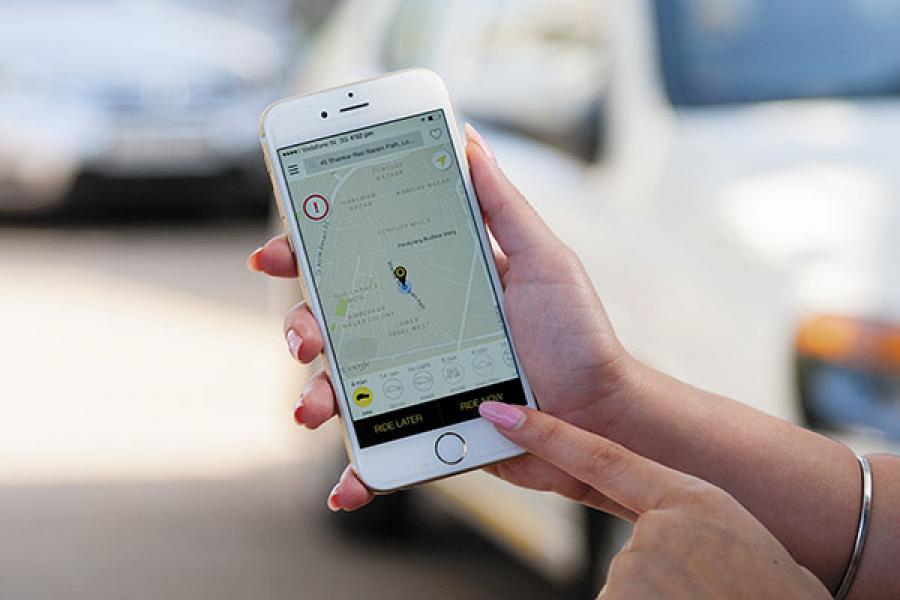
Ola: Taking India on a ride
In just four years, Ola has become the market leader in the cab service space, ahead of Meru and Uber. No wonder, investors can't get enough of this Bengaluru-based startup
Forbes India Leadership Award: Outstanding StartUp

Bhavish Aggarwal, 29, co-founder and chief executive and Ankit Bhati, 28, co-founder and chief technology officer, are, simply put, investor baits.
Consider that their four-year-old startup is valued at $2.5 billion—the third highest valued consumer internet company in India. Since 2011, when it was set up, Ola (formerly Ola Cabs) has raised a little over $900 million from over a dozen investors in at least eight rounds (see box Constant Inflow). This includes angels, marquee venture capital firms and hedge funds. The lure of this home-grown cab aggregator has proved irresistible to investors. And not all of it was about the sector opportunity or the company’s business model: “I was very impressed with Bhavish. He gave me a sense of confidence. He is quiet but very confident and very determined to create value,” says Anupam Mittal, founder and chief executive of People Group, who was among the first to write out a cheque to the young firm.
He wasn’t immediately convinced, though. When Aggarwal first approached Mittal in 2011, the angel investor had dismissed the business plan, saying the odds were stacked against the founders as the personal travel market in India was largely dominated by the government and unions. And the organised cab market was led by radio taxi services like TABcab, EasyCabs, Meru and Mega Cabs, which had company-owned and franchised fleet, unlike the marketplace model that was proposed by Ola.
Despite declining the proposal the first time, Mittal and fellow angel investor Rehan Yar Khan decided to take a closer look at the business. Mittal met Aggarwal a second time. And, this time, he was in. “For me, it was about backing Bhavish. I knew he and Ankit would walk the talk. If things don’t work out, they will create something else but they will succeed,” he says. Mittal continues to be invested in Ola and is sitting on “exorbitant” returns (his highest so far, though unrealised).
Ola’s founders know that gaining investor confidence is a by-product of realising the vision of building mobility for a billion Indians. But their business vision, so clear now, did not evolve overnight. Neither did the investor dollars. In fact, for the IIT Bombay graduates, it all started with less than Rs 10,000 in Aggarwal’s bank account and a tight smack of failure.
The entrepreneurial bug bit Aggarwal in 2010, when he was working as a coder for Microsoft India in New Delhi. In August that year, braced with savings of about Rs 1 lakh, he started olatrip.com, a trip planning firm offering weekend getaway tours around Delhi. Over the next five months, Aggarwal could not sell a single trip. Customers could arrange hotels for themselves but what they really needed was a vehicle to take them to the destination, he realised. This demand was a hint of the potential for cabs. But, says Aggarwal, “I had no money, no co-founder (Bhati, who was doing his Masters, joined in December) and I had no product. Commonwealth Games were on at that time and I would go and distribute pamphlets (for olatrip.com) outside the stadia. I had nothing to lose… it was not depressing or demoralising.”
In the process, Aggarwal had exhausted his savings and was left with less than Rs 10,000 in his bank account. In January 2011, he bit the bullet. Along with Bhati, he started Olacabs, an online taxi aggregation firm, with operations only in Mumbai. Moving to India’s financial capital was not a difficult decision for Aggarwal because he knew the city better (both he and Bhati had graduated from IIT Bombay); also his girlfriend lived there! Neither was starting a new venture immediately after the failure of the first one a problem: They believed they had nothing to lose. “I was 24 when I started. I had a girlfriend, but I wasn’t married. I had no money, so there was no risk of losing it,” he jokes, sitting in his plush conference room in the Ola head office in Bengaluru. (They shifted from Mumbai in 2012.)
Initially, Aggarwal survived on the three credit cards that he had from his Microsoft days—he spent two years with the IT giant. “For a year, I would spend through credit cards because cash was more important. The credit card guys kept following up with me… I have paid off all the dues,” he clarifies, laughing.
At first, Mumbai was tough on the duo. They weren’t drawing salaries for themselves and even had to borrow Rs 6,000 in February 2011 from a friend to pay their house rent.
With no cash in hand and ambitious plans in place, they needed to raise funds and started scouting for external investments. The process was trickier than they thought. “I went to an angel, saying ‘investment kar do’ (please make the investment). He asked me to send the op [operations] structure of the company… I had no idea what an op structure was,” says Aggarwal. He came back and researched what it was, and “spent the next day making the op structure. There were only two people—Bhati and I, what could the op structure be?”
That is how Ola got its initial round of angel funding in 2011: Rs 2.7 crore from Anupam Mittal and Orios Venture Fund’s Rehan Yar Khan, among others. Ola had crossed the first hurdle to becoming India’s largest cab aggregator.
India’s cab market, which is primarily unorganised, is about $6 billion and increasing at 25-30 percent year-on-year, according to industry estimates. Aggarwal and Bhati realised that the growth opportunity was considerable in this segment—they just needed to scale fast.
Having garnered investor
interest early enough, this did not prove to be a problem. After its initial round of funding in 2011, there was no looking back for them. In 2012, Ola raised its Series A funding of $5 million from Tiger Global Management. In 2013, it raised its Series B funding of $20 million from Matrix Partners and Tiger Global. Then, in 2014, the company caught the attention of Hong Kong-based equity hedge fund Steadview Capital that, along with Sequoia Capital and existing investors, poured $41.5 million into Ola. In October last year, the startup hit the headlines after raising an eye-popping $210 million from global investors, including SoftBank Internet and Media Inc (SIMI) and existing investors Tiger Global, Matrix Partners and Steadview Capital. Ola’s Series D round was one of the largest fund-raises in the Indian consumer technology and mobile space at the time. In its Series E funding round this year, it raised $400 million led by Russian billionaire Yuri Milner-founded DST Global, with participation from GIC, Falcon Edge Capital and existing investors SoftBank Group, Tiger Global, Steadview Capital and Accel Partners US.
This sustained investor interest is also a reflection of the promoters’ understanding of the relationship between the two parties. As Bhati says, it is extremely important to have clear communication and exhibit the company’s core values to the investors. They are apprised of Ola’s decision-making framework, and know what to expect from the company and its founders, he says. “Expectations are set in a pattern… there are no surprises, no unnecessary friction. We are clean and clear to our investors. That’s the basic hygiene of our relationship,” says Bhati.
The steady flow of funds ensured that Ola has maintained over 40 percent month-on-month growth since its inception as a cab aggregator (as opposed to the ownership model prevalent at the time. Think Meru, TABcab, etc). Its proprietary technology for drivers across commercial transport vehicles helps them connect with customers looking for a safe ride. Using the Ola mobile app, users across over 100 cities can book from over 2,50,000 cabs and another 65,000 vehicles across auto-rickshaws, kaali-peeli (black and yellow) taxis and yellow taxis (in Kolkata).
The co-founders currently hold undisclosed minority stakes in Ola. They don’t look at growth in terms of just revenues and market share. They are targeting profits now: Ola and its investors expect the Bengaluru-based firm to become profit before tax (PBT) positive by 2017-18. After all, profitability is the biggest question mark on consumer internet companies in India right now, with concerns on sustainability given zero cash generation. To combat this, the company is creating a cash coffer for itself. A constant supply of capital is almost imperative for the survival of companies in the consumer internet space. In its latest round of funding in mid-September, Ola raised around $225 million as part of a $500-million round that is expected to close soon, according to a report in Mint. This comes just a few weeks after Uber said it would invest $1 billion into India over the next six to nine months. Uber claims that it is growing at the same pace as Ola, at 40 percent month-on-month in India, and would clock more than one million daily rides by March 31, 2016.
Having already left its home-grown competition behind, Ola has its eye on innovating Uber out of the market.
Ola claims that it has 80 percent market share in the cab services market, while Meru holds 12 percent, followed by Uber and others at 4 percent each.
Imagine auto-rickshaws on demand. You couldn’t have, till Ola brought the feisty three-wheeler onto its platform late last year. This idea came from an intern, Aggarwal tells Forbes India, and was integrated into their business plan almost immediately. Today, the company has around 65,000 auto-rickshaws and kaali-peeli taxis on its platform (with around 40,000 three-wheelers in the mix). Next, Ola is adding chartered and tourist buses on its platform. It launched the shuttle bus service in September, starting with Gurgaon and Bengaluru.
The goal is to become a one-stop transportation solutions provider, pipping Uber to the post. “Uber has been around for a while. We were very small when Uber started two years ago but we scaled better because we are very, very local. For drivers, we are a local brand,” says Aggarwal.
Ola says it offers over 7,50,000 rides a day and is adding 1,500 cabs every day to its current fleet of 2,50,000 cabs. In September, Ola started buying cabs and lending them to new drivers. The initiative is a part of Ola’s move to become a part inventory model, to create exclusive and long-term relations with drivers and thwart competition from Uber. Ola, so far, hadn’t owned cars.
By December 2015, at least 10,000 cars are expected to be on-road under the leasing model. Ola will be investing Rs 500 crore to begin with, and will raise funds independently for this business in the time to come. Another Rs 5,000 crore of capital will be infused into this programme in the coming year, they say.
Technology inevitably is the other area of focus for Ola as it gears up to stay on top of competition and increase demand. To this end, the company is hiring talent from the US. Its technology team now comprises over 500 employees. “We need to have the smartest people in the world in our tech teams. That’s how technology companies remain relevant. They constantly upgrade themselves,” says Aggarwal, who was part of Forbes India’s first-ever 30 Under 30 list in 2014.

Safe to say, if you are an Ola employee, you have your plate full.
Not surprisingly, almost everyone at Ola’s head office seemed glued to their computer screens when Forbes India visited. You can attribute it to the culture of the company, says Aggarwal. “Our culture is about doing something in life and working towards a mission. It’s not about chilling at work. It can’t be masti karenge (let’s have fun),” he points out. “Being a startup, there is obviously a lot to do. People who want to do something, or create something, thrive in startups. Maybe that’s why there is some work-life imbalance in all startups, not just in Ola, Flipkart or Snapdeal per se.”
The company is supportive of employees who want to work on their business ideas. In certain cases, it even allows time off to those who want to work on their business models. It has also hired back people whose ventures didn’t take off. Its attrition rate is at par with industry standards, says Aggarwal. Ola now has an employee strength of 6,000.
Even the two co-founders had to keep up with the fast scaling growth. Those who are close to the company say Aggarwal and Bhati have evolved dramatically as leaders over the last four years.
Roles are clearly defined between Aggarwal and Bhati. While Aggarwal, the CEO, is the business head, Bhati, the CTO, is the tech brain. Those who work closely with the duo say Bhati is not just solving current problems, but also looking at issues that may crop up four to five years later. “Bhavish has the first principle approach on things and tends to think from scratch. Ankit is very strong on seeing beyond the obvious,” says Pranay Jivrajka, chief operating officer, Ola. Jivrajka says it is the agility and nimbleness of the founders that has brought Ola to where it is today. “They are very adaptable and change with time.”
Aggarwal has put together a bunch of advisers from within the company, who help him strategise the next level of growth for Ola. Further, his ability to learn is significant. “Whether it’s about moving the company to Bengaluru (from Mumbai in 2012), buying TaxiForSure (in 2015) to now getting into buses, Aggarwal is able to see the big inflection point and take bets,” says Mittal.
His business partner and friend Bhati thinks Aggarwal’s biggest evolution lies in his power to delegate. Earlier, they would do everything themselves. While in engineering Bhati can afford to stay involved, Aggarwal seems to have easily transitioned from doing things himself to delegation. It is not an easy thing to do, says Bhati. “It’s very difficult to delegate something that you are so passionate about. I am not sure I can do it as well as he did it,” says Bhati.
While the two co-founders are close friends, differences in opinion is a given. “We agree to disagree,” quips Bhati, adding that both know their roles and responsibilities and believe in giving each other honest feedback. One such disagreement took place when Ola was launching its iOS app. The team which was handling this app was small but Aggarwal wanted to launch the app right away. Bhati thought taking more time would be sensible. Finally, the app was launched immediately. “In hindsight, it was a right call and yes, we delivered,” says Bhati.
Stress is inevitable in the running of the business but there are rarely any raised voices. “Whatever problems we face, we take a call, execute as fast as possible, move on and evolve,” says Jivrajka.
They don’t have the time for skirmishes. Their plans are too demanding for that: Over the next 60 months, the company wants to be in a high growth phase and drive mobility and transportation for Indians across cities and towns. “Our yardstick is that people should stop relying on personal cars—we will offer a service better than that,” says Bhati. Well, he has certainly convinced his co-founder to go ‘carless’: Aggarwal takes an Ola whenever he steps out.
(This story appears in the 16 October, 2015 issue of Forbes India. To visit our Archives, click here.)

















